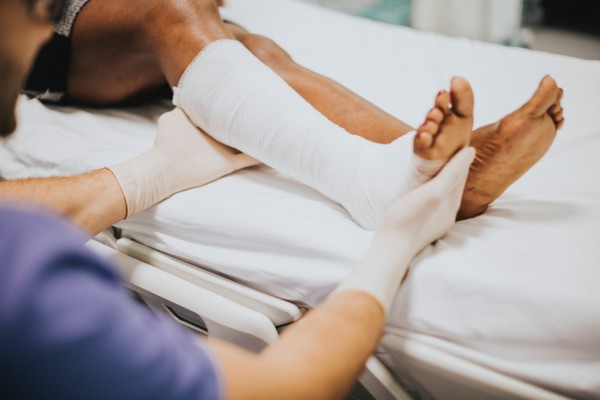New Report Calls For Global Efforts To Prevent Fragility Fractures Due To Osteoporosis

Today, the International Osteoporosis Foundation (IOF) released a new report, revealing approximately 80 percent of patients treated in clinics or hospitals following a fracture are not screened for osteoporosis or risk of future falls. Left untreated, these patients are at high risk of suffering secondary fractures and facing a future of pain, disfigurement, long-term disability and even early death.
The report 'Capture the Fracture - A global campaign to break the fragility fracture cycle' calls for concerted worldwide efforts to stop secondary fractures due to osteoporosis by implementing proven models of care. Prof. Bess Dawson-Hughes, Professor of Medicine at Tufts University School of Medicine and General Secretary of IOF, warned, "Half of all individuals who go on to suffer a hip fracture have already come to clinical attention because of a prior fragility fracture.
It is obvious that health professionals are missing a clear warning signal. All too often the broken bone is simply 'repaired' and the patient is sent home without proper diagnosis and management of the underlying cause of the fracture." She added, "This care gap results in countless avoidable fragility fractures at a cost of many billions of dollars worldwide.
With the launch of the IOF Capture the Fracture campaign and this report, we are urging health care professionals and health authorities to implement proven cost-effective measures that will ensure that these high-risk individuals receive the necessary assessment and care to prevent further fractures.
IOF's report was issued today at a joint media event with the National Osteoporosis Foundation (NOF) and Osteoporosis Canada in anticipation of World Osteoporosis Day, observed annually on October 20. World Osteoporosis Day, led by IOF with participation in more than 90 countries, launches a year-long campaign dedicated to raising global awareness of the prevention, diagnosis, and treatment of osteoporosis and related musculoskeletal diseases.
Representatives from IOF, NOF, National Bone Health Alliance (NBHA), Osteoporosis Canada and a patient will be present to speak about IOF's report findings and the importance of raising global awareness of osteoporosis as part of World Osteoporosis Day and subsequent year-long campaign.
"Today's press conference has three major bone groups coming together around the urgency of fracture prevention. We have the evidence, we know what systems work and we know it is cost-effective to implement coordinated models of care for secondary fracture prevention - now is the time to do it," said Judy Stenmark, CEO, IOF.
Osteoporosis sufferer and speaker at the event, Jeannie Joas, was diagnosed two years ago and has had one wrist fracture as a result. An avid exerciser and healthy eater, Jeannie is one of the many men and women surprised by their diagnosis.
"Two years ago when my bone density test showed significant bone loss since the last test, the doctor thought it was a mistake and ordered it be repeated, only to learn it was true," Joas said. "I'm active, fit, exercise regularly and have always taken care of my health, including being a 'milkaholic' throughout my life. How could I be told I have osteoporosis?"
Fractures: a socio-economic burden:
Around the world, up to 1 in 2 women and 1 in 5 men over 50 years of age will suffer a fragility fracture. Fractures are a tremendous burden on older people and healthcare budgets, with costs exceeding that of many other age-related diseases, including stroke, MS and Parkinson's disease.
Vertebral and hip fractures, in particular, can result in substantial pain and suffering, disability and loss of quality of life. Around 20 percent of hip fracture sufferers die in the year following the fracture while 33 percent of seniors who suffer a hip fracture become physically impaired and lose their ability to live independently.
One study showed that during the year 2000, there were an estimated 9 million new fragility fractures worldwide, of which 1.6 million were at the hip, 1.7 million at the wrist, 0.7 million at the humerus and 1.4 million symptomatic vertebral fractures. In 2002, all osteoporotic fractures in the United States alone cost $20 billion per year.
International efforts to 'capture' and treat high-risk patients:
As outlined in the 'Capture the Fracture' report, a systematic literature review found the majority of successful systems for secondary fracture prevention throughout the world have employed a dedicated coordinator. The coordinator acts as the link between the orthopedic team, the osteoporosis and falls services, the patient and the primary care physician.
Giving examples of successful and cost-effective service models from many countries, the report outlines the solid evidence in favor of these systems of care. All over the world health authorities and patient organizations are increasingly recognizing the importance of secondary fracture prevention.
In the U.S., NBHA launched 2Million2Many, a national campaign that aims to break the fracture cycle by calling on the public and healthcare professionals to request an osteoporosis test when someone 50 years or older breaks a bone. As part of this initiative, NBHA created a visual representation of the 5,500 bone breaks that occur every day called Cast Mountain. "In the U.S., we know there are two million bone breaks that occur each year due to osteoporosis.
The sad reality is only two in 10 patients with initial bone breaks get a follow-up test or treatment for osteoporosis," said Professor Robert Lindsay, chief of Internal Medicine, Helen Hayes Hospital, Columbia University and chair, NBHA 2Million2Many Project Team. "The number of annual fractures is expected to swell to around three million and cost the healthcare system $25 billion per year by 2025, hence NBHA's '20/20' vision to reduce the incidence of bone breaks by 20 percent by 2020."
Jul 24, 2019 01:41 AM EDT





